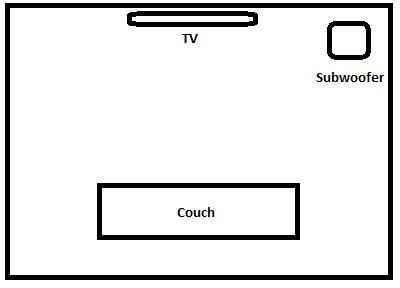Getting deep, accurate bass in your home theater is not just about connecting your home theater subwoofer to the receiver. You need to find a perfect position to place your subwoofer in your home theater for the best bass output. Also, you need to know how to configure your subwoofer for accurate and deep bass. In this article, we’ll discuss how to install a subwoofer for the best bass output in a home theater room.
The Importance of Subwoofer Placement
Essentially, all the speakers in your home theater setup interact with the room. Lower frequencies, collectively known as bass, interact more with a room than higher frequencies. If you’re wondering how that happens, try playing some music with deep bass and walk around the room. Listen to the music while moving from one location of the room to another. You’ll notice that your sound system doesn’t sound the same in different locations.
Parallel surfaces affect the performance of a subwoofer significantly. Essentially, low-frequency waves are omnidirectional. Thus, they naturally bounce across the walls in a home theater room. When bass waves reflect off parallel walls, they bounce back into each other. As a result, you may experience bass nulls or standing waves in the room.
Standing waves are excessive bass energy. As a result, you’ll hear boomy bass without accuracy. Bass nulls, on the other hand, are dead spots resulting from bass waves that cancel out each other.
You can only deal with these problems by ensuring the subwoofer is properly placed in the best position in your home theater room. Also, you need to ensure the subwoofer controls are properly adjusted. Upon finding a perfect subwoofer placement location, you can use the EQ to adjust the bass output.
Also read: Discover the Best 10 Inch Subwoofers for Mind-Blowing Bass
How to Install a Subwoofer in a Home Theater Room
One of the most effective subwoofer setup ideas is to observe proper subwoofer placement in your home theater. Essentially, most audiophiles place their subwoofer against a wall or in a corner. However, you won’t get top-quality bass output with such placement. Although this works for smaller subwoofers, larger subwoofers should be placed some inches away from the wall for the best bass output.
Here’re some subwoofer placement ideas that can help you get the most out of your home theater subwoofer.
1. Move your couch
If your room is spacious enough to place a subwoofer anywhere, you’ll find it easier to get the best listening position. To do this, move your couch or chair from its usual location. Next, place your subwoofer on the spot where the couch was positioned. Play some music and move around the room until you get the spot where bass sounds well-defined, deep, and even.
Try several spots and mark the best spots with tape. Once you find the perfect spot, move the subwoofer to that spot. Next, move your couch back to its original position. That way, you’ll hear accurate bass response from your listening position.
2. Subwoofer placement at the front
Another great subwoofer installation idea is to position it at the front. Preferably, place the subwoofer beside the TV. It should be placed at about a third of the wall length. At this position, you’ll reduce standing waves and nulls for more accurate bass response.
3. Best placement for subwoofer in a corner
While some subwoofers are not ideal for placement in a corner, some sound best in this position. If you’re setting up a subwoofer with a port on the rear, seal the port with a cloth or tennis ball to prevent the bass from interacting with the wall behind. If the subwoofer has a rear at the front, then you don’t have to seal it. Ensure you place the subwoofer about 8 inches away from the corner.

4. Where to place two subwoofers
If you want enhanced bass output, consider setting up two subwoofers. With two subwoofers, you’ll reduce standing waves when you place them properly in the home theater room. Also, two subwoofers reduce the strain on your home theater system. They’ll play loudly without turning the volume to the maximum, which would otherwise result in distortion.
For the best results, place both subwoofers at the front wall, at least 8 inches from the corners. To do this, place one subwoofer near the right front corner and the other subwoofer near the left front corner.
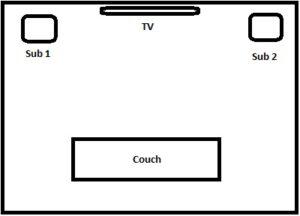
Another option is to place the subwoofers diagonally at opposite corners. That way, there’s lower room resonance for higher quality bass response.
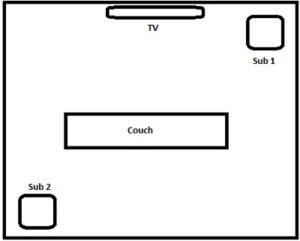
5. Where to place four subwoofers
If you prefer tighter and deeper bass, you can consider adding four subwoofers in your home theater. You can position each speaker in one corner, at least 8 inches away from the corner.
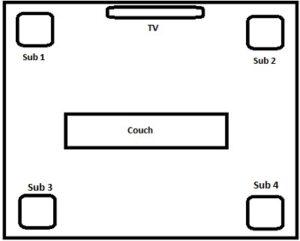
Another subwoofer placement option when dealing with four subwoofers is to place each subwoofer on the middle of each wall.

6. Subwoofer Placement with Soundbar
If you have a soundbar in your home audio setup and you want to add a subwoofer, it’s important to place the subwoofer appropriately. Preferably, place the soundbar at the front center, just below the TV. Then place the subwoofer either near the front left or front right corner.
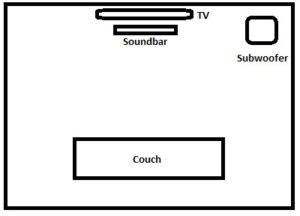
How to Install a Subwoofer and Configure it
Upon finding a perfect position to place your subwoofer, you need to configure it to enhance the bass output. Some subwoofers have an automated calibration system that allows you to set the best crossover settings. However, some subwoofers require manual calibration using the dials or buttons on the control panel. Here’s how to set up your subwoofer manually.
1. Setting up the crossover
One of the main subwoofer configurations you’ll need to do is to adjust the crossover. Essentially, you’ll need to turn the crossover control all the way up. If your AV receiver is advanced, it may take over the crossover control such that you won’t have to use the built-in subwoofer crossover.
If you’re not using the crossover on the receiver or preamp, set the subwoofer crossover to a level that produces the kind of bass you want. You can check the frequency response rating of your subwoofer for better configuration. Ideally, set the crossover about 10Hz higher than its lowest frequency response for the best bass output.
2. Setting up the phase
Next, play some bass-intensive music and listen to the bass output keenly. If you notice any drop in bass, adjust the phase until the bass stops dropping energy. If adjusting the phase doesn’t eliminate the problem, you probably need to adjust the subwoofer placement.
3. Adjusting the subwoofer volume
Some audiophiles make the mistake of turning the subwoofer volume to the maximum. However, doing so may cause distortion. Preferably, turn the volume to approximately 75 percent. Then increase the subwoofer level on the receiver for louder bass. While turning the volume up, do it in small increments until you get the loudness you want without any distortion.
Final Thoughts
Bass interacts with a home theater room significantly. Thus, it’s important to place your subwoofer properly in the room. If your budget and room size allows, place two or four subwoofers in the home theater for more accurate and even bass output throughout the room. Now that you know how to install a subwoofer and the best subwoofer placement ideas, you’ll enjoy improved bass quality in your home theater.
Related articles:
How Does a Subwoofer Work – Complete Beginner’s Guide
Subwoofer Vs Soundbar- Which Offers Better Sound?
Mastering Home Theater Speaker Placement for Surround Sound

Kenny Owen is an acclaimed audio expert and longtime enthusiast with a deep passion for sound technology. With over 15 years of experience in the car and home audio industry, Kenny has established himself as a trusted authority on everything from speaker setups and amplifier configurations to the latest audio equipment and innovations.
Through his engaging writing style and meticulously researched articles, Kenny shares his vast knowledge on optimizing audio systems for superior sound quality. He provides in-depth tips and tricks for achieving the best listening experience, whether it’s tuning a car’s audio system for an immersive musical journey or creating a high-fidelity home theater setup. Additionally, Kenny’s comprehensive buying guides empower readers to make informed decisions when investing in audio components, ensuring they get the most bang for their buck.

Kenny Owen is an acclaimed audio expert and longtime enthusiast with a deep passion for sound technology. With over 15 years of experience in the car and home audio industry, Kenny has established himself as a trusted authority on everything from speaker setups and amplifier configurations to the latest audio equipment and innovations.
Through his engaging writing style and meticulously researched articles, Kenny shares his vast knowledge on optimizing audio systems for superior sound quality. He provides in-depth tips and tricks for achieving the best listening experience, whether it’s tuning a car’s audio system for an immersive musical journey or creating a high-fidelity home theater setup. Additionally, Kenny’s comprehensive buying guides empower readers to make informed decisions when investing in audio components, ensuring they get the most bang for their buck.
